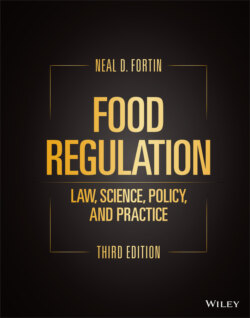Читать книгу Food Regulation - Neal D. Fortin - Страница 145
3.8 ALLERGENS Food Allergen Labeling and Consumer Protection Act of 2004 (FALCPA)
ОглавлениеThe FALCPA of 200472 amended the Federal FD&C Act to create a category of “major food allergens.” FALCPA require special identification of major allergens in food that contains a major food allergen or contains a derivative of a major allergen.
The act defines “major food allergen” as any of the following:
milk,
eggs,
fish,
crustacea,
tree nuts,
wheat,
peanuts, and
soybeans.
sesame (effiective jan. l, 2023)
The declaration that a food contains a major food allergen must be met by one of the following:
1 Stating the common or usual name of the food allergen in the list of ingredients followed in parentheses by the name of the food source from which the major food allergen is derived (unless the common or usual name of the ingredient uses the name of the food source or the name of the food source appears elsewhere in the ingredient list); or
2 Stating immediately after or is adjacent to the list of ingredients, “Contains,” followed by the name of food source from which the major food allergen is derived.73
If the labeling includes an allergen “Contains” statement, then all major allergens must be included in the statement even if the common name of the allergen is already listed in the ingredient statement. This is designed to protect against consumer misunderstanding and confusion from the omission.
Note that the list of “major food allergens” consists of five individual food sources, such as milk and peanuts, and three categories of foods, fish, crustacea, and tree nuts. These categories include many individual foods, so the list of major food allergens contains more than eight allergens. In addition, FDA interprets the categories broadly. Thus, by FDA’s count there are twenty‐nine major allergens under FALCPA.
The act requires allergens in flavoring, coloring, or incidental additives to also be labeled in accordance with these requirements. Thus, although flavorings or colorings may be listed generically, a major allergen source must be specifically declared. Similarly, the incidental additive exception from ingredient labeling does not apply to major allergens.
To gain an exemption from the FALCPA labeling requirements, the law provides for a petition for exemption and for a notification of exemption.
